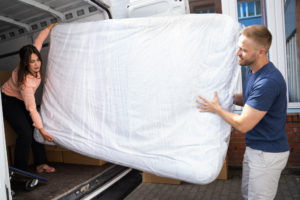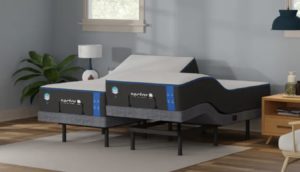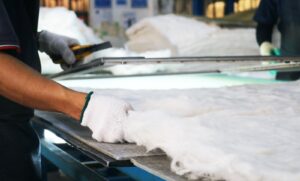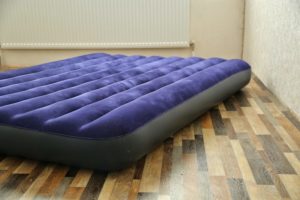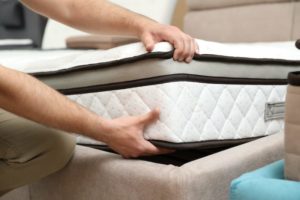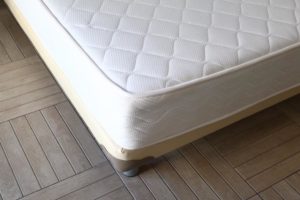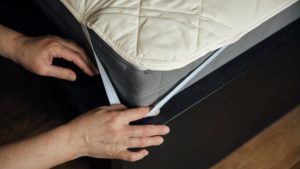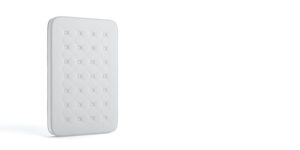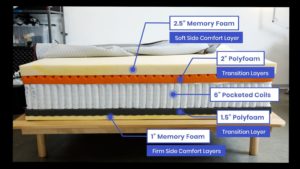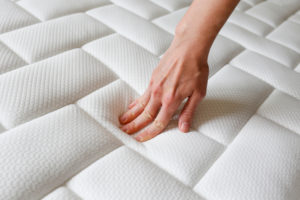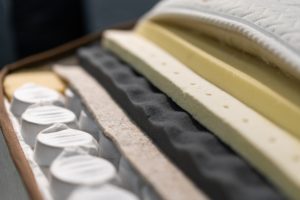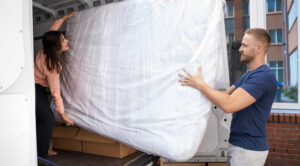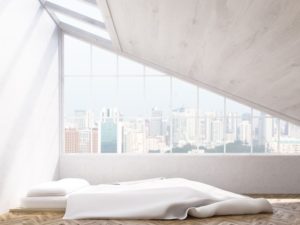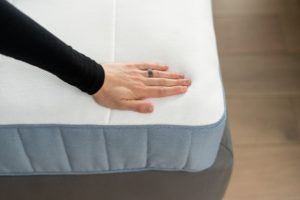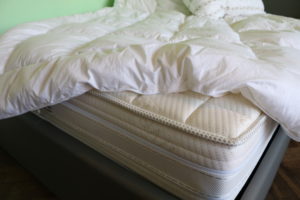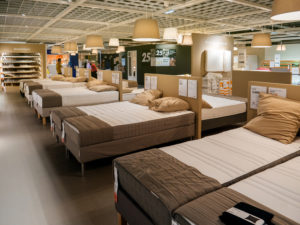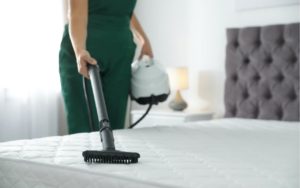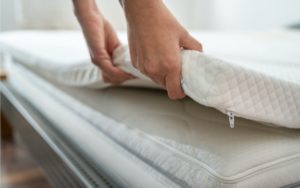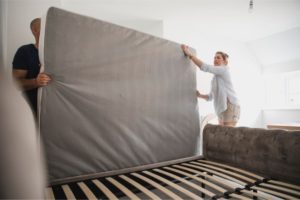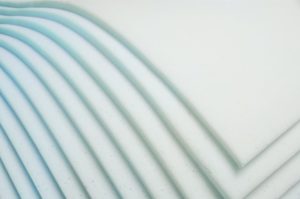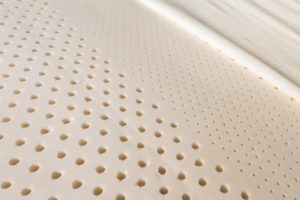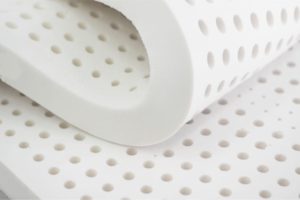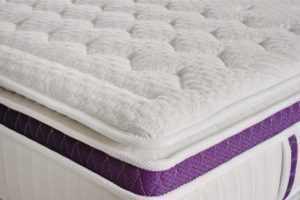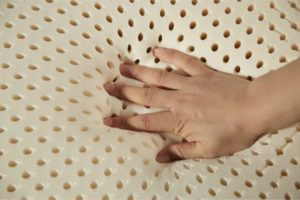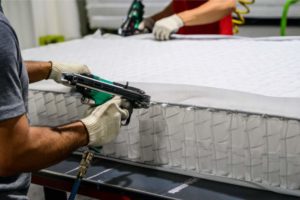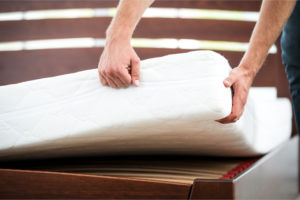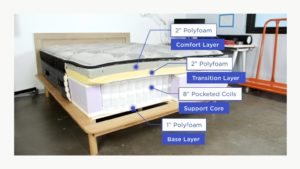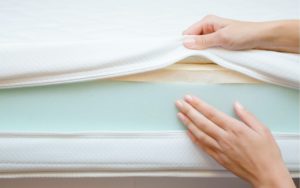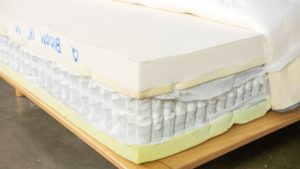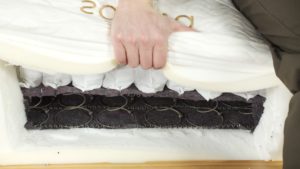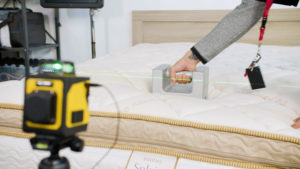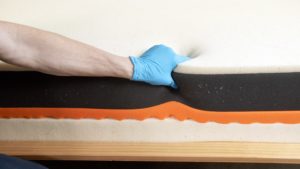Mattress Types
On the surface, a mattress seems like a simple product, and some people may even think that all mattresses are more or less the same.
The reality, though, is much more complicated. Under the cover, a mattress can be built with numerous different designs and materials. This interior construction is the most clear-cut factor affecting how a mattress will feel and how long it will last.
Those interior components define the main types of mattresses. While not all the mattresses of a certain type will have the same performance, there are common characteristics that derive from how a bed is built. For that reason, learning about the types can be a useful step in your search for the best mattress to meet your individual needs.
Every sleeper has their own set of preferences and needs, which means that there’s no one perfect mattress for everyone. Knowledge is power when looking for a new mattress, this guide explains the different mattress types along with their benefits and downsides so that you can shop with confidence.
Let us help you find the perfect bed
Answer a few questions to find the right mattress for your unique needs
How Many Types of Mattresses Are There?
For all intents and purposes, mattresses that are widely available on the market today can be grouped into one of five categories: innerspring, foam, hybrid, latex, and airbed.
The type of mattress is determined by its construction and materials. While there are some rare or exotic mattress designs that don’t fit into those five categories, those exceptions are not likely to be considerations for the vast majority of mattress shoppers.
How Much Does Each Mattress Type Cost?
The price range for mattresses is vast and includes low-quality, low-cost options to high-end models for those in the lap of luxury. That diversity in price can make it hard to state definitively how much a mattress normally costs.
Despite that difficulty, we’ve tried to give a general idea of the average price of most mattress types in a Queen size. Again, there are outliers from these ranges, but these averages provide a general sense of the retail pricing and an idea of how it compares between mattress types.
| Mattress Type | Typical Price Range (Queen) |
|---|---|
| Innerspring | $600-1,100 |
| Foam | $900-1,300 |
| Hybrid | $1,300-2,000 |
| Latex | $1,600-2,000 |
| Airbed | $2,000-2,400 |
With any mattress in any category, prices can rise or fall based on the specifics of how that mattress is made. Factors that can play a part in the final price include:
- How many layers are in the mattress
- The thickness of the layers
- The material used in each layer
- Where and how the materials were sourced (e.g., organic products)
- Whether the mattress was made in the USA
- If the mattress has any special features (cooling properties; reversible firmness; sewn-on handles, etc.)
For any mattress type, shoppers should always be on the lookout for deals and promotions and should almost always receive some discount from the full sticker price (MSRP).
Which Type of Mattress is Best?
No one type of mattress is the best in all cases. However, for some sleepers, one type of mattress can be a better fit and provide more consistent, pain-free sleep.
Part of choosing a mattress involves evaluating the different mattress types in detail to understand their pros and cons and determine which is best for you.
All About Innerspring Mattresses
| Support Core | Coils |
| Comfort System Profile | Minimal |
| Comfort System Materil(s) | Foam, latex, cotton, wool, and/or polyester |
| Strengths | Edge support Bounce Temperature regulation Price |
| Weaknesses | Pressure relief Motion isolation Durability Noise |
The central feature of an innerspring mattress is its coil-based construction. The coils compress when pressure is applied to them and then spring back quickly when that pressure is removed. In this way, an innerspring offers some ability to accommodate the body’s weight for both comfort and support.
An innerspring does not have a substantial comfort layer above the coils. Any layers on top are of minimal thickness and influence on the overall feel. Thin layers of fabrics like cotton and polyester are the most commonly used to give an innerspring a touch of softness.
The responsiveness of innerspring mattresses makes them bouncy and generally good for sex. Most innersprings have average or better edge support, and because air can flow easily through the coils, they rarely have heat retention problems.
The lack of a significant comfort system means that pressure relief is usually lacking on an innerspring, especially for side sleepers and others with major pressure points. Coils transfer motion, making a partner´s movement more notable. Direct pressure from the body on the coils can make them wear out quickly, detracting from the lifespan of the mattress. Coils may also squeak when compressing, causing innersprings to be noisier than other mattress types.
Until recently, coil-based mattresses have been the norm in the mattress industry. With many new types on offer, innerspring popularity has dropped. Despite this, abundant coil-based options can be found online and in stores.
Because their design is less robust, innersprings are regularly available at a lower price than other mattress types. For that reason, they are a common choice as an entry-level mattress among shoppers with a limited budget.
Are There Different Types of Innerspring Mattresses?
There are several types of innerspring mattresses that are distinguished by the types of coils that they use. While the overall performance is similar across these types, there are notable differences in feel and in price.
Bonnell coils are traditionally the most widely used and tend to have the lowest price. Each coil has an hourglass shape and is attached to an interior frame made up of a network of wires. Because the coils are more tightly bound together, when one compresses, it puts more pressure on the coils around it, transferring more motion.
Offset coils look like Bonnell coils, but they have a different system for connecting the springs. Instead of directly attaching the coil itself to the lattice framework, they are slightly set apart and connected with a small, separate piece of metal. With added independent range of motion, offset coils have slightly more contouring and motion isolation than Bonnell coils.
Continuous wire coils, as the name implies, involve having all of the individual springs and lattices out of one single piece of wire. Their performance is similar to Bonnell coils.
Pocketed coils take a different approach to constructing the innerspring support core. Each coil is covered in fabric, and then the fabric casings are sewn together. In this way, the coils themselves are not directly attached. For this reason, they have considerably more ability to move and compress without affecting the surrounding coils, improving contouring and motion isolation. Pocketed coils are also known as individually-wrapped, fabric-encased, or Marshall coils.
How Much Variation is There Between Innerspring Mattresses?
There is a moderate level of variation between innerspring mattresses. The main elements that cause this variation include:
- The type of coils
- The number of coils
- The thickness (gauge) of the coils
- The height of the coil layer and mattress as a whole
- The quality of the steel (including whether it is tempered or double-tempered)
- The materials in any layers above the coils
An innerspring with high-quality pocketed coils and a soft cotton layer above them will offer more support, motion isolation, comfort, and durability than a low-quality mattress with Bonnell coils and no comfort layer.
Despite these differences, customers can reliably generalize about the overall performance of mattresses in the innerspring category. While there are degrees of variation, their basic benefits and downsides are similar.
All About Foam Mattresses
| Support Core | Polyfoam |
| Comfort System Profile | Significant |
| Comfort System Material(s) | Memory foam, polyfoam, latex, cotton, wool, and/or polyester |
| Strengths | Pressure relief Motion isolation Low noise |
| Weaknesses | Edge support Bounce Temperature regulation |
Foam mattresses are one of the most popular types on the market today. In these mattresses, every layer is made with foam, latex, or fabric; there are no coils involved in the construction.
The support core of a foam mattress is almost always a thick layer of polyfoam. This support polyfoam is firmer and denser than other polyfoams that may be used in the comfort system.
The comfort system can include one or more layers and may include memory foam, polyfoam, latex, or other fabrics. The ample comfort system allows a foam mattress to provide higher levels of pressure relief, motion isolation, and noise reduction. Quality foam mattresses have above-average durability, lasting 6-8 years and sometimes even longer.
The downsides to foam mattresses can include issues with heat retention, excess sinking into the bed, lack of bounce, and weak edge support. How much these issues arise depends in large part on the specific type and quality of materials used in the comfort system.
Are There Different Types of Foam Mattresses?
There are many different variations of foam mattresses because there are hundreds of ways that the interior layers can be arranged.
For example, memory foam mattresses describe all-foam beds in which memory foam is a primary material in the comfort system. For most other foam mattresses, there is no specific term used for the different methods of construction and layering.
How Much Variation is There Between Foam Mattresses?
The ability to carefully construct the interior layers of a foam mattress means that there is the potential for significant variation among models in this category.
Of the materials that are often found in all-foam comfort systems, each has certain strengths and weaknesses.
| Memory Foam | Polyfoam | Latex | Cotton / Wool / Polyester | |
|---|---|---|---|---|
| Contouring | High | Medium to High | Low to Medium | Low |
| Bounce | Low | Medium to High | High | Low |
| Motion Isolation | High | Low to Medium | Low to Medium | Low |
| Temperature Regulation | Low to Medium | Medium to High | High | Medium to High |
Remember that any specific material can be formulated to be softer or firmer, which can influence how it performs in these categories.
In addition, the feel of a mattress is based on the sum of its parts, and these materials are often used together in the layers of the comfort system. As a result, in multi-layer designs, it’s important to consider the mattress based on its construction as a whole rather than just one material.
What Are Gel-Infused Foams?
Gel-infused foams incorporate a gel into the material itself to try to reduce heat buildup. The gel is either swirled into the foam or is contained in beads that are distributed within the foam.
The impact of gel-infusions is a matter of debate. Some sleepers find that gel-infused foams sleep cooler while others detect little difference. The overall benefit may depend on the type of gel and the surrounding mattress design; however, in most cases, there is little downside to using a gel-infused memory foam or polyfoam.
All About Hybrid Mattresses
| Support Core | Coils |
| Comfort System Profile | Significant |
| Comfort System Material(s) | Memory foam, polyfoam, latex, cotton, wool, and/or polyester |
| Strengths | Bounce Temperature regulation Balanced features |
| Weaknesses | Price Motion isolation Heavier/bulkier |
Hybrid mattresses have an innerspring support core that works in tandem with a substantial comfort system. With this construction, hybrids cultivate a balanced feel that works to obtain the positives of multiple components while minimizing their negatives.
In most hybrids, the innerspring core is built with pocketed coils. These enhance the motion isolation of the mattress while increasing edge support and bounce relative to all-foam beds. Because the coils retain little heat, hybrids generally provide solid temperature regulation.
While pocketed coils can cut down on motion transfer, more movement is perceptible across a hybrid than on most foam beds. Hybrids can be heavier, more difficult to move, and more expensive than other mattress types.
The comfort system of a hybrid can be made with numerous layers and combinations of materials. Pocketed micro-coils can be used for a coil-on-coil construction. Memory foam, polyfoam, latex, and textile fabrics can all be employed as well.
The exact design of the comfort system is a critical consideration for any hybrid because it has a profound impact on performance. While virtually any hybrid will reflect certain standard characteristics, the range of mattress feel among hybrids is significant.
Are There Different Types of Hybrid Mattresses?
There are many versions of hybrid mattresses. All hybrids have two common components: an innerspring support core and a significant comfort system. However, the composition of the comfort system can vary widely, making for ample diversity in the models of hybrids available.
How Much Variation is There Between Hybrid Mattresses?
Hybrids can vary significantly, reflecting the enormous number of ways that a comfort system can be constructed.
The comfort layers can include the same materials as those found in foam mattresses; however, they may also include micro-coils. Those materials play a central role in the performance of a hybrid
| Memory Foam | Polyfoam | Latex | Cotton / Wool / Polyester | |
|---|---|---|---|---|
| Contouring | High | Medium to High | Low to Medium | Low |
| Bounce | Low | Medium to High | High | Low |
| Motion Isolation | High | Low to Medium | Low to Medium | Low |
| Temperature Regulation | Low to Medium | Medium to High | High | Medium to High |
Most hybrids utilize more than one of these materials to generate a multi-faceted feel that can cushion the body without losing bounce or edge support from the underlying coils. Additionally, many hybrids are offered with a choice of firmness levels, letting customers elect the feel that best suits their preferences.
Customers who want deeper contouring and motion isolation from a hybrid generally prefer those with memory foam in the comfort system, and people who want more bounce and temperature regulation lean toward comfort systems with latex, micro-coils, and/or latex-like polyfoams.
All About Latex Mattresses
| Support Core | Latex |
| Comfort System Profile | Moderate to Significant |
| Comfort System Material(s) | Latex |
| Strengths | Bounce Temperature regulation Durability Low noise |
| Weaknesses | Motion isolation Price Heavier/bulkier |
Latex mattresses are made entirely with this rubber material and may also be known as all-latex or true-latex mattresses. Both the support core and the comfort system are made with latex, although they may employ different kinds of latex.
In most of these beds, the support core is made with a latex formulated to be denser and firmer in order to provide heft and stability. The comfort system generally uses latex designed to have more contouring than the type used in the support core.
Latex has the ability to conform to the body to relieve pressure and promote spinal alignment. However, it does not contour or hug the body as deeply as a material like memory foam. This can be a pro or con depending on the needs of any given sleeper.
A notable aspect of latex is its bounce. It quickly retakes its shape when weight is removed from it, giving it significant responsiveness that makes it easy to move on the mattress. As a result, it is a top choice for people who want a mattress that is good for sex.
Latex effectively resists heat buildup and stays quiet. Among mattress materials, latex is one of the most durable options available.
Because of its bounce, latex can transfer more motion than materials like memory foam. It isolates enough motion for most couples, but people who are especially sensitive to movement on the bed might find it to be disruptive.
The price of latex beds has come down quite a bit in recent years, but as a whole, these mattresses are on the expensive side. Their heavy weight can make them more challenging to lift and move.
Are There Different Types of Latex Mattresses?
There are several kinds of latex mattresses that are differentiated by the type of latex that they use. Most often, you’ll see latex referred to as either natural or synthetic.
Natural latex is produced from a milky white raw material derived from rubber trees. That sap is mixed with curing agents that allow it to be formed into a final product with a specific shape and feel. Two processes are used to create natural latex:
- The Dunlop process takes the sap, froths it, and then pours it in a mold. It is then baked at a high temperature to retain the shape of the mold. During the baking process, some sediment moves toward the bottom, so Dunlop latex tends to be slightly denser and firmer on one side.
- The Talalay process starts the same way, whipping sap into a froth and putting it into a mold. It is then vacuum-sealed and quickly frozen before being baked, limiting the sediment flow that happens in the Dunlop process. As a result, Talalay latex has a more consistent texture that is usually lighter and airier.
While there is a difference in feel between Dunlop and Talalay latex, both have a high degree of bounce and durability. Either type can be effectively used in any part of an all-latex mattress; however, Talalay latex is more commonly employed in comfort layers because of its lighter, softer feel. Talalay latex typically costs slightly more than Dunlop latex.
Latex can also be produced using petroleum-based chemicals. This is known as synthetic latex, more formally known as Styrene-Butadiene Rubber (SBR). Synthetic latex is not found as often in mattresses because it tends to have worse performance and reduced durability. Its primary benefit is a lower price point.
Blended latex uses a combination of natural and synthetic inputs. For a blended latex, the proportion will normally be listed, and most often, it is 70% synthetic and 30% natural.
How Much Variation is There Between Latex Mattresses?
While not all latex mattresses are the same, there is less variation than exists in other mattress types. Nearly every latex mattress will exhibit bounce and solid temperature regulation. The biggest differences among latex options will be their firmness level, depth of contouring, and degree of motion isolation. Those aspects of mattress performance can fluctuate based on the type of latex used and whether it has been formulated to be softer or firmer.
The main exception is mattresses made with synthetic latex which may have fewer benefits in terms of support, contouring, and durability.
Other Mattress Types
In the previous sections, we covered the five main mattress types, but there are some other kinds of mattresses that you might come across in your research.
Airbeds
A clear distinguishing feature — the use of an air chamber support core — defines airbeds and makes them stand out from other approaches to mattress design.
In an airbed, the support core is incredibly adjustable. A pump can put air in or pull it out of the chamber, making it possible to switch up the feel of the mattress at any given time. The pump is easily controlled with a smartphone app or controls that are either attached or wireless.
In almost all airbeds that are Full-size or larger, each side of the mattress has a separate air chamber. This allows the person on either side to set the firmness level to their liking, which is a huge selling point for couples. Some airbeds have different air chambers underneath various parts of the body, providing for even greater flexibility in tailoring the cushioning to fit the individual.
Pillow-Top Mattress
A pillow-top is a style of mattress design in which a layer of material is placed in a compartment that sits on top of the rest of the mattress. That compartment is then stitched to the top part of the underlying bed.
A pillow-top isn’t really a type of mattress so much as a design feature. It can be used on any of the five mattress types that were described previously. A pillow-top is often, though not always, used to give the mattress a plusher feel.
In a Euro-style pillow top (or Euro-top), the extra material at the top is not in an entirely separate compartment; instead, it is stitched within the overall mattress cover. A Euro-style pillow top has a similar feel as a regular pillow-top but has a more compact and uniform look.
Organic Mattress
An organic mattress is made with materials that meet certain standards for natural production. These are usually identified by organic certifications such as the Global Organic Latex Standard (GOLS) or Global Organic Textile Standard (GOTS). In most cases, it is individual components and not the mattress itself that has received the certification.
The great majority of organic mattresses are made with latex. The reason for this is that foams, metal coils, and air chambers generally have inputs or production processes that cannot be certified as organic. Nevertheless, some of those beds may take steps to reduce their environmental footprint and/or may include natural materials like an organic cotton or wool cover.
Waterbed
Though they were a hit in the 1980s, waterbeds have faded in popularity and are rarely used today. These mattresses use a support core made of tubes filled with water, and the water moves along with the body, creating a floating-like feel.
Not only were waterbeds lacking in terms of true support for the body, but they could cause huge problems if the water chambers ruptured from a defect or wear-and-tear. For this reason, many apartment and condominium lease agreements prohibit the use of these beds because of the risk of water damage.
Futon and Sofa-Beds
Futons and sofa-beds operate on the same principle of being able to serve as either a couch or a bed. In a futon, one large cushion sits on a frame that can lie flat or be held at an angle. Futons are convenient for providing a temporary bed, but they rarely deliver the kind of support needed for sleeping on them night after night.
In a sofa-bed, the cushions can be removed to fold-out a frame for a thin mattress. As with a futon, a sofa-bed is best utilized over a short timeframe because of the lack of support from the mattress. For example, it’s not uncommon to feel the bars of the frame through the sofa-bed’s mattress.
If a futon or sofa-bed has to be used for an extended period, it is often worth considering purchasing a mattress topper that can contribute a degree of comfort and contouring to help avoid morning aches and pains.
Temporary Air Mattress
Not to be confused with an airbed, an air mattress is meant for temporary use. These are generally made with a vinyl casing that form an air chamber that can be inflated or deflated with either a built-in or external pump. When deflated, the mattress folds up for easy storage in a closet.
Temporary air mattresses are useful in a pinch, but they suffer from a lack of contouring and support. They are also not built to last for the long-term. To make them easier to store, the vinyl is not especially thick. As a result, if they are used consistently over a period of weeks or longer, they are at risk of leaks and punctures.

Still have questions? Ask our community!
Join our Sleep Care Community — a trusted hub of sleep health professionals, product specialists, and people just like you. Whether you need expert sleep advice for your insomnia or you’re searching for the perfect mattress, we’ve got you covered. Get personalized guidance from the experts who know sleep best.

